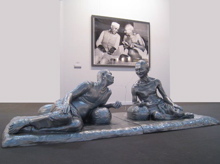
Hasnat Mehmood: I Love Miniature I
Debanjan Roy: Experiments with Truth
In recent years, the Asian artists who have dominated the Western museums and art market have been predominantly Chinese. But coming up from the rear now are a generation of young artists from the Indian subcontinent. Like their Chinese counterparts, their work is infused with contemporary preoccupations, particularly the clashes between their traditional civilization and a new, global, hi-tech society.
Just as a new crop of Indian writers has brought modern India bursting onto the best seller lists, so the Indian and Pakistani artists now on show at the AICON Gallery present us with sometimes shocking reconsiderations of past and present in their native lands. In a way, it's unfair to combine Hasnat Mehmood's intricate, delicate miniatures with Debanjan Roy's wham-bam shiny red sculptures in one space. Mehmood's works, principally digital prints and drawings on scratchboard and paper, many composed only of lines and circles, explore an evolving Pakistani art form -- the miniature painting movement -- by copying the work of better-known painters and earlier images.
The work, though small, is full of surprises: braille lettering on each piece explains the image; lines and dots are used to connote everything from figures to psychological traps. The ideas in the works are as intricate as their form. Debanjan Roy is not so subtle. Rather, his images are designed to shock and disorient. Seeing sculptures of Mahatma Gandhi strolling rapt in his iPod, or lying back in a Laz-E-Boy recliner, or seated in his trademark loincloth at a computer station, makes for an uneasy experience. That they're all painted in bright, fire-engine red, the artist explains, is to foreshadow Gandhi's violent death.
Other works on show by Roy feature more of India's famous faces: political leaders Nehru and Indira Gandhi, a handful of deities, and many of its most famous symbols: animals, lotus flowers, the ocean. Then you notice the images worked alongside of them: a convertible with a GPS system, headphones, cell phones, ubiquitous computers. The combinations are strong and provocative, funny and unnerving all at once. They even feel sacrilegious, somehow, as they place the country's most venerated figures alongside its booming, westernized present. Love the sculptures or hate them, the questions they raise about the transformation of a culture are the right ones at the right time.
AICON Gallery, 35 Great Jones St #1, New York, NY, through August 1.
